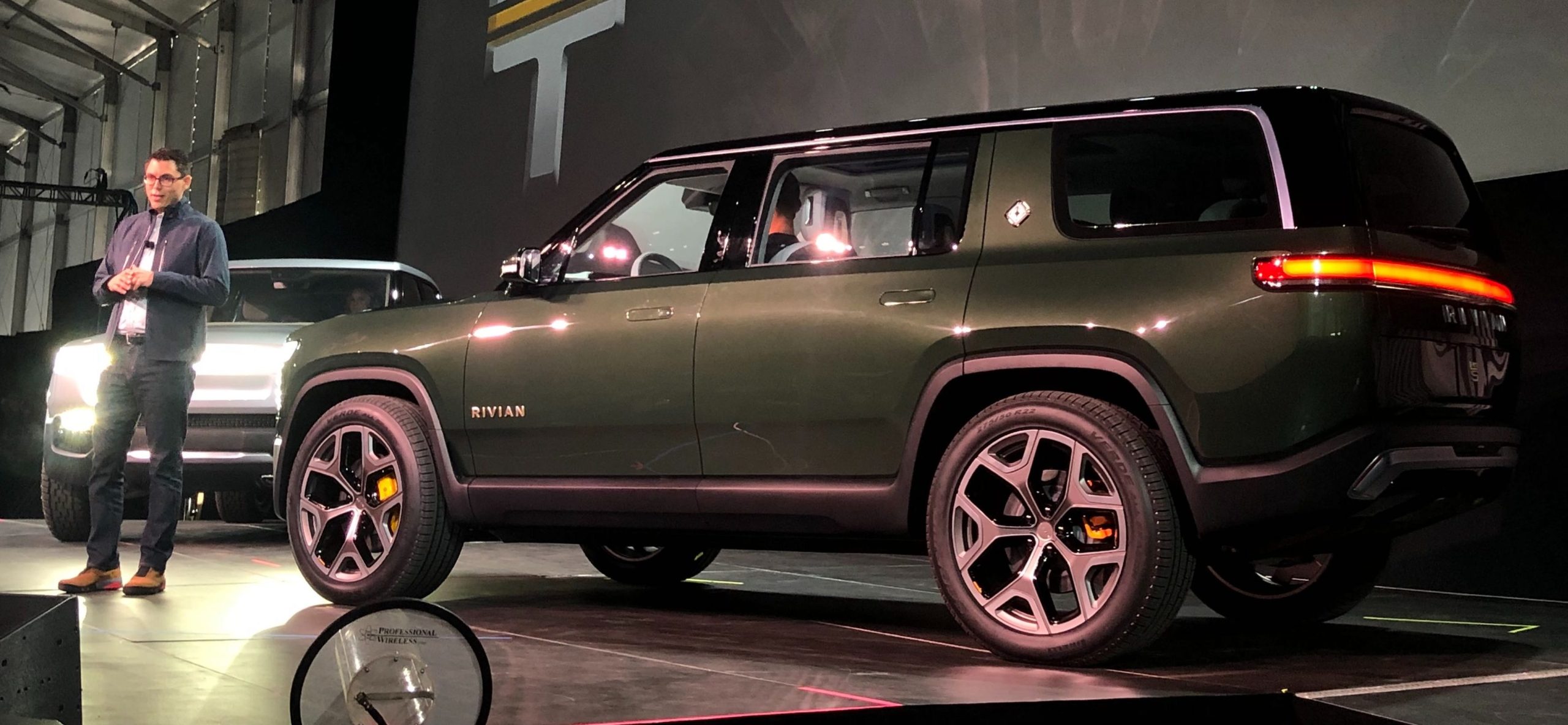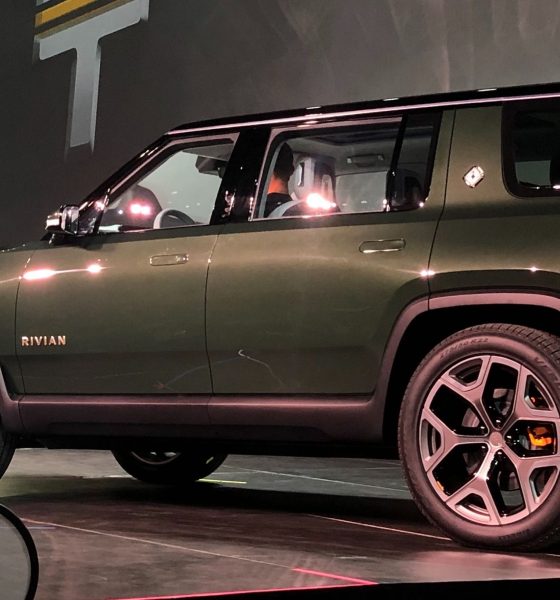

News
Tesla gets nod from Rivian CEO for combating ‘untruths’ about electric vehicles
The long, arduous road that Tesla traveled over the past years was recently acknowledged by RJ Scaringe, the 35-year-old CEO of electric vehicle maker Rivian. During a fireside chat at the Automotive News World Congress, Scaringe noted that his 10-year-old company aims to do to pickup trucks and off-road-capable SUVs what Tesla did to the performance and premium automotive segments. That is, he wants Rivian to disprove any untruths that are currently prevalent in the truck and SUV industry.
“I think any great brand … to build a brand that customers are going to be excited about and that customers are going to want to be part of, it has to fundamentally reset expectations. It has to disprove untruths. Tesla took the untruth that electric cars were boring and slow — that they were glorified golf carts — and they disproved that. They showed people that an electric car can be exciting and fun. What we need to disprove is that an electric vehicle can’t get dirty, and that an electric vehicle can’t be rugged, and an electric vehicle can’t go off-road and take your family places, and that an off-road vehicle can’t be good on-road,” he said.
Rivian’s first two vehicles, the R1T pickup truck and the R1S SUV, seem perfectly capable of playing the part. Rivian impressed the EV community and the auto industry when it emerged after 10 years of operating on stealth mode. Both vehicles are well-rounded and refined, created through years of work by a team that included alumni from McLaren (yes, that McLaren). Both have four electric motors that provide immense power and torque, both offer range of over 400 miles per charge, and both are built with intelligent driver-assist features that can transition into full self-driving in the future. During the R1T’s unveiling last November at the historic Griffith Observatory in Los Angeles, Rivian’s intentions of tapping into the premium EV market were evident.

During his recent fireside chat, Scaringe mentioned that the market Rivian is going for are people who own adventure vehicles and luxury vehicles. In a later statement, Scaringe expressed a point related by Elon Musk during the days of the original Roadster, when he noted that the small, two-door high-performance sports car should perform on the same level as the best fossil fuel-powered cars around. For Scaringe, this same point stands true for the R1T and the R1S.
“We want to get the guy who already has a Range Rover sitting next to a Tesla [in the garage], or the [Jeep] Wrangler sitting next to the [BMW] i3, and grab them with something that was just completely different than what they thought was possible. It will be the best-driving truck or SUV in the world. It must be, because if it’s not, why would somebody pick us over a Ford or over a BMW?” he said.
For now, though, Scaringe noted that Rivian is determined to learn from the experiences of companies like Tesla, while integrating concepts from established automakers such as GM and Toyota. With the successful unveiling of its first vehicles, after all, Rivian is about to tackle one of the hardest parts of being an automaker — actually building cars.
“We do recognize the complexity of assembling and putting vehicles together, of managing a very complex supply chain and logistics network, and we’re very [cognizant] of the nuts and bolts, and of the need to follow a proper process to ensure that, when we launch the vehicle, it can be launched with as few problems, errors, and challenges as possible,” Scaringe said.

When Elon Musk wrote his Master Plan Part Deux, he openly admitted that it is very difficult to become successful in the United States’ auto market. Considering the number of automakers that have gone under, Musk lightly noted that starting a car company is downright idiotic, and starting an electric car company is “idiocy squared.” As foolhardy as the venture might have been, though, Tesla has thrived, driven by an ever-increasing demand for its premium electric cars and energy storage products. The Model 3, the company’s most affordable vehicle to date, has been making a dent in the US’ auto market, becoming the overall best-selling luxury car in the country last year.
It has not been easy for the Silicon Valley-bred carmaker. The Model 3 ramp, for one, is described by Elon Musk as one of the most difficult periods of his career. Musk bet Tesla’s future in the electric sedan, and it took longer than expected to reach the company’s self-imposed production targets. Nevertheless, since hitting its goal of producing 5,000 Model 3 per week at the end of Q2 2018, Tesla has steadily improved its footing with the electric car’s production. In Q3 2018, Tesla even posted a profit. The fourth quarter of 2018 might be just as successful.
If Rivian’s strategy so far is any indication, though, the company stands a good chance of avoiding some of the challenges faced by Tesla during the ramps of the original Roadster, the Model S, X, and 3. Rivian, for one, has already secured a facility in Normal, Ill. The company is also working closely on the development of its vehicles’ battery packs. Apart from this, Rivian is also consulting the veterans of the auto industry. In his recent appearance at Autoline After Hours, for one, auto teardown specialist Sandy Munro, who conducted a thorough analysis of the Tesla Model 3, mentioned that Rivian is one of his firm’s clients.

News
Tesla FSD fleet is nearing 7 billion total miles, including 2.5 billion city miles
As can be seen on Tesla’s official FSD webpage, vehicles equipped with the system have now navigated over 6.99 billion miles.

Tesla’s Full Self-Driving (Supervised) fleet is closing in on almost 7 billion total miles driven, as per data posted by the company on its official FSD webpage.
These figures hint at the massive scale of data fueling Tesla’s rapid FSD improvements, which have been quite notable as of late.
FSD mileage milestones
As can be seen on Tesla’s official FSD webpage, vehicles equipped with the system have now navigated over 6.99 billion miles. Tesla owner and avid FSD tester Whole Mars Catalog also shared a screenshot indicating that from the nearly 7 billion miles traveled by the FSD fleet, more than 2.5 billion miles were driven inside cities.
City miles are particularly valuable for complex urban scenarios like unprotected turns, pedestrian interactions, and traffic lights. This is also the difference-maker for FSD, as only complex solutions, such as Waymo’s self-driving taxis, operate similarly on inner-city streets. And even then, incidents such as the San Francisco blackouts have proven challenging for sensor-rich vehicles like Waymos.
Tesla’s data edge
Tesla has a number of advantages in the autonomous vehicle sector, one of which is the size of its fleet and the number of vehicles training FSD on real-world roads. Tesla’s nearly 7 billion FSD miles then allow the company to roll out updates that make its vehicles behave like they are being driven by experienced drivers, even if they are operating on their own.
So notable are Tesla’s improvements to FSD that NVIDIA Director of Robotics Jim Fan, after experiencing FSD v14, noted that the system is the first AI that passes what he described as a “Physical Turing Test.”
“Despite knowing exactly how robot learning works, I still find it magical watching the steering wheel turn by itself. First it feels surreal, next it becomes routine. Then, like the smartphone, taking it away actively hurts. This is how humanity gets rewired and glued to god-like technologies,” Fan wrote in a post on X.
News
Tesla starts showing how FSD will change lives in Europe
Local officials tested the system on narrow country roads and were impressed by FSD’s smooth, human-like driving, with some calling the service a game-changer for everyday life in areas that are far from urban centers.

Tesla has launched Europe’s first public shuttle service using Full Self-Driving (Supervised) in the rural Eifelkreis Bitburg-Prüm region of Germany, demonstrating how the technology can restore independence and mobility for people who struggle with limited transport options.
Local officials tested the system on narrow country roads and were impressed by FSD’s smooth, human-like driving, with some calling the service a game-changer for everyday life in areas that are far from urban centers.
Officials see real impact on rural residents
Arzfeld Mayor Johannes Kuhl and District Administrator Andreas Kruppert personally tested the Tesla shuttle service. This allowed them to see just how well FSD navigated winding lanes and rural roads confidently. Kruppert said, “Autonomous driving sounds like science fiction to many, but we simply see here that it works totally well in rural regions too.” Kuhl, for his part, also noted that FSD “feels like a very experienced driver.”
The pilot complements the area’s “Citizen Bus” program, which provides on-demand rides for elderly residents who can no longer drive themselves. Tesla Europe shared a video of a demonstration of the service, highlighting how FSD gives people their freedom back, even in places where public transport is not as prevalent.
What the Ministry for Economic Affairs and Transport says
Rhineland-Palatinate’s Minister Daniela Schmitt supported the project, praising the collaboration that made this “first of its kind in Europe” possible. As per the ministry, the rural rollout for the service shows FSD’s potential beyond major cities, and it delivers tangible benefits like grocery runs, doctor visits, and social connections for isolated residents.
“Reliable and flexible mobility is especially vital in rural areas. With the launch of a shuttle service using self-driving vehicles (FSD supervised) by Tesla in the Eifelkreis Bitburg-Prüm, an innovative pilot project is now getting underway that complements local community bus services. It is the first project of its kind in Europe.
“The result is a real gain for rural mobility: greater accessibility, more flexibility and tangible benefits for everyday life. A strong signal for innovation, cooperation and future-oriented mobility beyond urban centers,” the ministry wrote in a LinkedIn post.
News
Tesla China quietly posts Robotaxi-related job listing
Tesla China is currently seeking a Low Voltage Electrical Engineer to work on circuit board design for the company’s autonomous vehicles.

Tesla has posted a new job listing in Shanghai explicitly tied to its Robotaxi program, fueling speculation that the company is preparing to launch its dedicated autonomous ride-hailing service in China.
As noted in the listing, Tesla China is currently seeking a Low Voltage Electrical Engineer to work on circuit board design for the company’s autonomous vehicles.
Robotaxi-specific role
The listing, which was shared on social media platform X by industry watcher @tslaming, suggested that Tesla China is looking to fill the role urgently. The job listing itself specifically mentions that the person hired for the role will be working on the Low Voltage Hardware team, which would design the circuit boards that would serve as the nervous system of the Robotaxi.
Key tasks for the role, as indicated in the job listing, include collaboration with PCB layout, firmware, mechanical, program management, and validation teams, among other responsibilities. The role is based in Shanghai.
China Robotaxi launch
China represents a massive potential market for robotaxis, with its dense urban centers and supportive policies in select cities. Tesla has limited permission to roll out FSD in the country, though despite this, its vehicles have been hailed as among the best in the market when it comes to autonomous features. So far, at least, it appears that China supports Tesla’s FSD and Robotaxi rollout.
This was hinted at in November, when Tesla brought the Cybercab to the 8th China International Import Expo (CIIE) in Shanghai, marking the first time that the autonomous two-seater was brought to the Asia-Pacific region. The vehicle, despite not having a release date in China, received a significant amount of interest among the event’s attendees.








